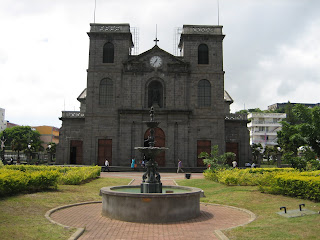




Following three days in Capetown, we had a day at sea and stopped next in Walvis Bay, Namibia. This port town is nothing more than a trans-shipment zone, with coal and containers piled up on the docks. It rained all day, a rare event. The desert begins about 1 mile inland. (see picture) We had a beautiful sunset as we left the port. This town had its modern roots as part of the German colony of Southwest Africa and it is directly west from the mines at Kimberly, and the cities of Pretoria and Johannesburg. Three days and fifteen hundred miles later, we’ve arrived on Easter Sunday at the Bom Bom Island, or, maybe I should say, islet. It is a speck of land adjacent to Principe. Principe and Sao Tome are the two main volcanic islands that comprise the Republic of Sao Tome and Principe. There is a small resort here and we had a day at the beach. (Three pictures) Get out your maps because it is off the west coast of Africa at 1.5 N and 7 E. The islands were uninhabited until the Portuguese arrived in the 15th century. Principe is notable because British scientist Arthur Eddington’s expedition came here to observe the total solar eclipse of May 29, 1919. This is where Paul Johnson chose to begin his story in Modern Times. The experimental observations made by Eddington confirmed predictions made by Einstein almost two decades earlier in his theory of relativity . For Johnson, this process: A theory validated(or invalidated) by objective experimental observation …represented an epitome of the scientific method as the way to discover the truth about our world. (He contrasts Einstein’s insistence on proof before acceptance with Freud, who demanded no such thing regarding his celebrated hypotheses about the sub-conscious mind.) For Einstein, it meant the Nobel Prize in 1922 and ascension to “rock-star” status. The Western world at large, their confidence in their institutions and certitudes severely shaken by the events of 1914-1918, translated relativity into relativism. So if space and time were not absolute, then neither were moral concepts. And where was God in this new cosmos? According to Johnson, into the void created by a shrinking God rushed the modern politician, one often unhinged from traditional morality and quite willing to subject his people to unproven theories. We will see some of the results of modern politics in the days ahead as we visit Ghana, Senegal and Togo.









